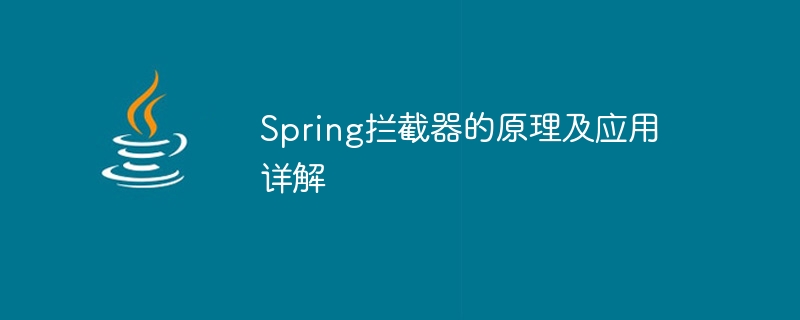Home >Java >javaTutorial >Detailed explanation of the principles and application scenarios of Spring interceptor
Detailed explanation of the principles and application scenarios of Spring interceptor
- 王林Original
- 2024-01-11 17:26:06808browse

Detailed explanation of the principle and application of Spring interceptor
- The concept and function of interceptor
Interceptor is a custom method provided by the Spring framework The pre- and post-call processing mechanism can perform some pre-processing and post-processing operations on the request before and after the request reaches the target method. Interceptors are similar to filters in Servlets and can perform unified processing on requests, such as authentication, logging, parameter verification, etc. The function of the interceptor is to add some custom logic before and after the execution of the target method, and can perform pre- or post-processing of certain operations. - Implementation principle of interceptor
In the Spring framework, the interceptor is implemented through the HandlerInterceptor interface and the HandlerInterceptorAdapter class. The HandlerInterceptor interface defines three methods: preHandle(), postHandle() and afterCompletion(), which are called before request processing, after request processing, and after view rendering respectively. HandlerInterceptorAdapter is an abstract implementation of HandlerInterceptor, which allows developers to only rewrite the required methods when customizing the interceptor. - Application scenarios of interceptors
3.1. Login authentication
In web development, it is often necessary to verify the user's login status. The interceptor can uniformly handle the user's login status. If the user is not logged in, he can jump to the login page for authentication; if the user is logged in, he can continue to perform subsequent operations.
3.2. Access control
Interceptors can be used to determine permissions on user requests. Only users with access permissions can perform certain operations, otherwise they will be intercepted and a corresponding error will be returned. information.
3.3. Logging
Interceptors can easily record request-related information, such as requested URL, request parameters, request method, execution time, etc., which can help us better track and troubleshoot problems. .
- Interceptor implementation steps
4.1. Create an interceptor class
First, create an interceptor class that implements the HandlerInterceptor interface, such as MyInterceptor, by rewriting preHandle(), postHandle () and afterCompletion() methods implement corresponding logic.
public class MyInterceptor implements HandlerInterceptor {
@Override
public boolean preHandle(HttpServletRequest request, HttpServletResponse response, Object handler) throws Exception {
// 在请求处理之前进行预处理
// 返回true表示继续执行,返回false表示拦截请求
return true;
}
@Override
public void postHandle(HttpServletRequest request, HttpServletResponse response, Object handler, ModelAndView modelAndView) throws Exception {
// 请求处理之后进行后处理
}
@Override
public void afterCompletion(HttpServletRequest request, HttpServletResponse response, Object handler, Exception ex) throws Exception {
// 视图渲染之后进行后处理
}
}4.2. Configuring the interceptor
Next, you need to configure the interceptor in the Spring configuration file. Apply interceptors to specific request paths or URLs through the
<mvc:interceptors>
<mvc:interceptor>
<mvc:mapping path="/api/**"/> <!-- 配置拦截的路径 -->
<bean class="com.example.MyInterceptor"/> <!-- 拦截器类 -->
</mvc:interceptor>
</mvc:interceptors>4.3. Apply interceptor
Finally, apply the interceptor to the specific Controller method. You can specify the order of interceptors by adding the @Interceptor annotation on the method.
@Controller
public class MyController {
@RequestMapping("/api/hello")
@Interceptor(Order=1)
public String hello() {
// 处理请求
return "hello";
}
}- Summary
Through interceptors, we can add custom processing logic before and after request execution to implement login authentication, access control, logging and other functions. Interceptor is a powerful extension mechanism provided by the Spring framework, which can well help us realize the need to process requests uniformly.
The above is a detailed analysis of the principle and application of Spring interceptor. I hope it can be helpful to readers. The use of interceptors is very flexible and can be expanded and customized according to specific business needs.
The above is the detailed content of Detailed explanation of the principles and application scenarios of Spring interceptor. For more information, please follow other related articles on the PHP Chinese website!
Related articles
See more- What are the principles and characteristics of blockchain
- SpringBoot interceptor implements login interception
- What are the three areas in which current computer application fields can be roughly divided?
- What does application data mean? Can it be deleted?
- How to implement interceptor function in Springboot

